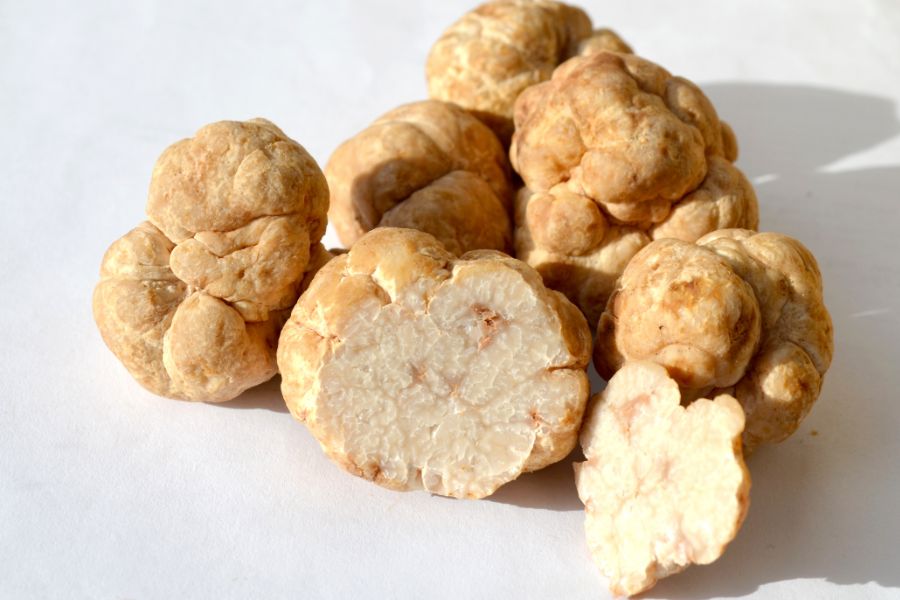Truffles aren’t just a European delicacy. Some species grow wild in the United States, and Michigan’s forests are one of the places they can be found. With the right mix of soil, trees, and humidity, these elusive fungi take root beneath the surface.
Certain hardwood forests create the perfect conditions for native truffles to form. The fungi develop underground near the roots and release a distinct aroma when mature. Locating them means tuning in to the land and the season.
Michigan holds more potential truffle territory than most people realize. But unless you know what to look for and where to start, they’ll stay hidden. The trick is narrowing your search to the woodlands that give them exactly what they need.
What We Cover In This Article:
- What Wild Truffles Look Like
- Truffle Lookalikes To Avoid
- Best Practices For Finding Truffles
- Where You Can Find Truffles Around The State
- Other Great Locations For Truffles
- When The Best Time Of The Year Is To Find Truffles
- The extensive local experience and understanding of our team
- Input from multiple local foragers and foraging groups
- The accessibility of the various locations
- Safety and potential hazards when collecting
- Private and public locations
- A desire to include locations for both experienced foragers and those who are just starting out
Using these weights we think we’ve put together the best list out there for just about any forager to be successful!
A Quick Reminder
Before we get into the specifics about where and how to find these plants and mushrooms, we want to be clear that before ingesting any wild plant or mushroom, it should be identified with 100% certainty as edible by someone qualified and experienced in mushroom and plant identification, such as a professional mycologist or an expert forager. Misidentification can lead to serious illness or death.
All plants and mushrooms have the potential to cause severe adverse reactions in certain individuals, even death. If you are consuming wild foragables, it is crucial to cook them thoroughly and properly and only eat a small portion to test for personal tolerance. Some people may have allergies or sensitivities to specific mushrooms and plants, even if they are considered safe for others.
The information provided in this article is for general informational and educational purposes only. Foraging involves inherent risks.
What Wild Truffles Look Like
The U.S. is home to several native truffle species that grow wild in forests across the country. Each one has its own unique scent, appearance, and preferred habitat. Here are the types of truffles you can find:
Oregon Black Truffles (Leucangium carthusianum)
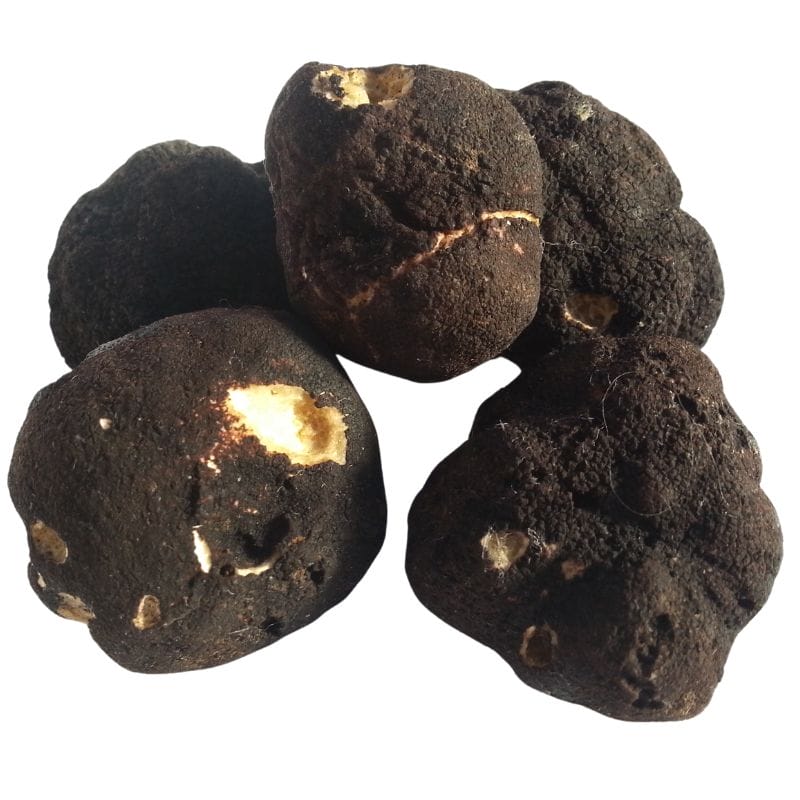
Leucangium carthusianum, also called the Oregon black truffle, grows in the Pacific Northwest and usually shows up around Douglas-fir trees. It’s a native species and one of the more well-known edible truffles from the region.
On the outside, it looks like a small lump of coal—dark black, kind of lumpy or warty, and sometimes slightly smoother in spots. They’re usually about the size of a golf ball, but they can be smaller or larger depending on the season.
Inside, the truffle is firm with a marbled pattern of gray and white veins running through it. When it’s fresh, it smells fruity, almost like pineapple, but the scent gets stronger and muskier as it ripens.
If you’re out looking for them, check in moist, shady forests with soft, loamy soil, especially where there’s a lot of moss or ferns. They grow just below the surface, so people often use trained dogs to help sniff out the ripe ones.
Compared to the Oregon white truffle, which is lighter in color and has a sharper, garlicky aroma, the black truffle has a deeper, more earthy smell. It’s also bigger and firmer than the southern U.S. truffles like Tuber lyonii, which tend to be smaller, paler, and grow around hardwoods like oaks and hickories.
Oregon Winter White Truffles (Tuber oregonense and Tuber gibbosum)
Oregon has two native white truffles that are starting to get more attention: the Oregon Winter White Truffle (Tuber oregonense) and the Oregon Spring White Truffle (Tuber gibbosum). They grow underground in forests and are prized for their strong, savory aroma.
From the outside, these truffles are small, roundish, and kind of bumpy, usually pale beige to light brown. Cut one open, and you’ll see a white interior that darkens with age, showing off a web of white veins when it’s fully mature.
The Winter White Truffle pops up from late fall into February, while the Spring White starts showing up around January and can last into June. They’re pretty similar, but the Winter variety is known for having a more powerful scent and flavor.
To find them, you’ll want to look in forests with younger Douglas-fir trees on the west side of the Cascades. Truffle hunters often check for loose soil or spots where animals have been scratching, which can be a sign there’s something below.
When fully ripe, both types give off a bold smell that’s often compared to garlic, cheese, or earthy spices. They’re usually served raw, shaved over dishes to add that truffle kick without losing any of the aroma.
Appalachian Truffle (Tuber canaliculatum)
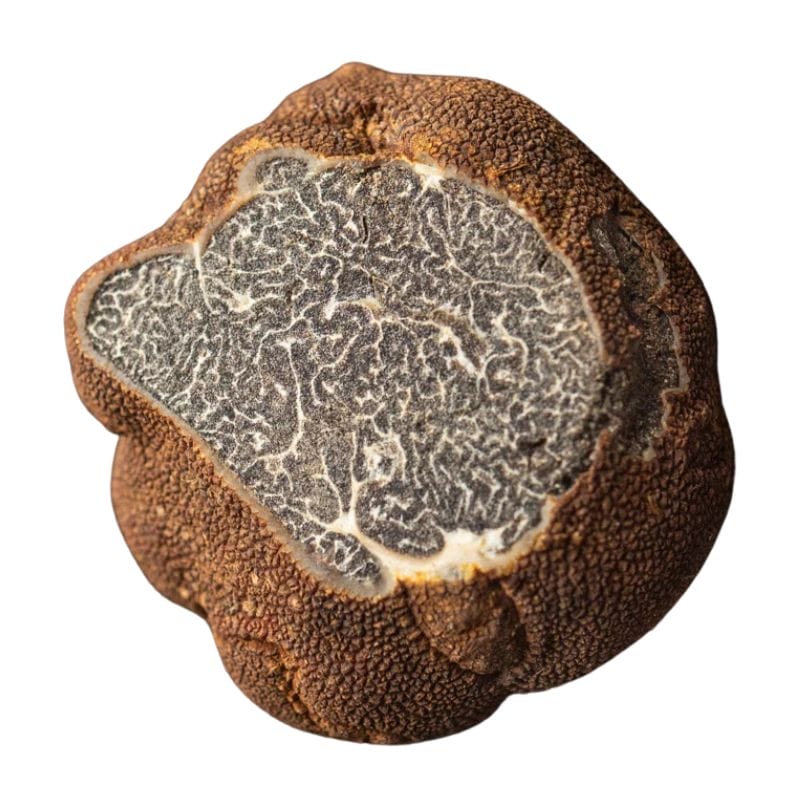
The Appalachian truffle, also known as Tuber canaliculatum, is a native North American truffle that’s slowly getting noticed. It’s about the size of a walnut and has a reddish-brown, bumpy outer surface that looks kind of like a rough, warty potato.
When you cut it open, the inside is firm and dark brown with thin white veins running through it like a marbled pattern. If it’s fully ripe, the smell is strong and earthy—some say it has a kind of nutty, funky aroma that stands out.
You can find these truffles in mixed hardwood forests, especially around oaks and pines, from late summer through fall. They grow underground, so look for spots where the soil is loose and animals like squirrels have been digging—sometimes that’s a good clue.
If you’re foraging, gently raking the top layer of soil near tree roots can help, but a trained dog or even a good nose makes it way easier. Once you know what to look for, the reddish color and bumpy skin are good signs you’ve found the right thing.
Compared to truffles like Tuber oregonense or Leucangium carthusianum, Tuber canaliculatum is more subtle in every way. Its smaller size and lighter scent mean you have to pay closer attention when foraging.
It’s also not as popular in the culinary world because it doesn’t pack the same punch in terms of flavor or aroma. Still, finding one can be rewarding, especially if you’re exploring different types of fungi in the area.
Desert Truffle (Terfezia and Tirmania spp.)
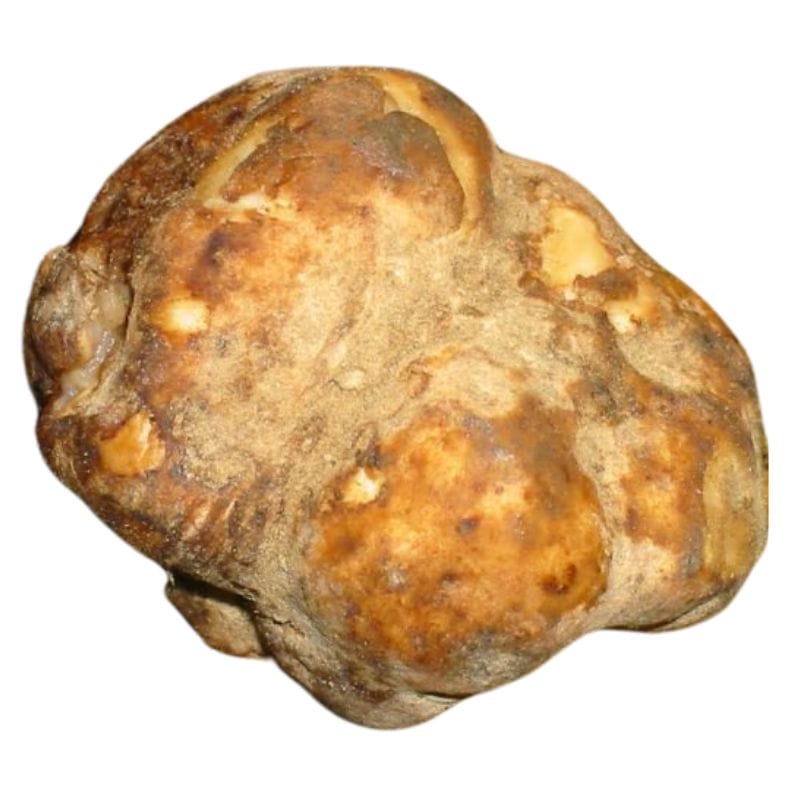
Terfezia and Tirmania are two types of truffles that are sometimes called desert truffles. These are a bit different from the truffles we usually think of, with their bold flavors and rich aromas.
These ones are a little more understated, but they’re fascinating in their own right. What makes them stand out is their ability to thrive in dry, harsh environments where you wouldn’t expect something so delicate to grow.
Unlike the earthy, intense aroma of black or white truffles, Terfezia and Tirmania truffles have a milder scent and flavor. They’re often described as nutty, with a hint of sweetness, but they lack the strong garlicky or musky notes you might associate with other truffles.
Their texture is also different—more firm and less oily than what you’d find with species like Tuber oregonense. They might not have the same culinary punch, but they’re still prized in traditional dishes, where their subtle flavors shine in simpler recipes.
When it comes to appearance, they’re easy to spot once you know what you’re looking for. They’re round to slightly irregular in shape, and their color can range from light beige to a reddish-brown, depending on the species.
The surface is usually smooth or slightly textured, without the rough, knobby look of a black truffle. Cut one open, and you’ll see a pale interior that’s often uniform in color, lacking the intricate veining you’d see in something like Leucangium carthusianum.
Pecan Truffle (Tuber lyonii)
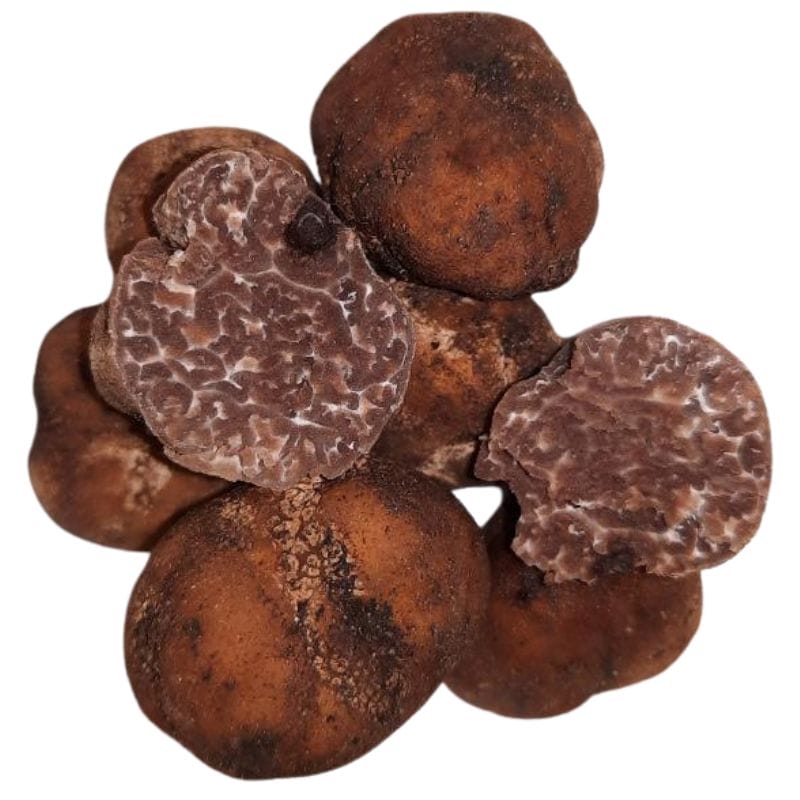
Tuber lyonii, also known as the pecan truffle, is a native North American truffle that grows underground near the roots of pecan trees. You’ll mostly find it in the southeastern U.S., especially in states like Texas, Georgia, and Mississippi.
On the outside, pecan truffles are round to lumpy and have a smooth, light brown skin that darkens as they age. They’re usually about the size of a marble or golf ball, and sometimes they even poke up slightly through the soil surface.
If you slice one open, the inside has a pretty marbled look—light tan streaks mixed with darker brown, almost like wood grain. The smell is earthy, nutty, and kind of warm, especially when they’re fully mature.
When you’re out looking for them, check under mature pecan trees or other hardwoods like oaks and hickories. Trained dogs can help sniff them out, but people sometimes spot them by looking for little cracks in the soil or raised areas near the tree’s base.
Compared to other U.S. truffles like the Oregon white truffle or the Appalachian black truffle, pecan truffles have a milder flavor and are more common in orchards. They’re a solid option in the kitchen—freshly sliced over pasta or mixed into butter—and they don’t come with the high price tag of their European cousins.
Truffle Lookalikes To Avoid
When you’re out hunting you also need to know about a few different fungi species that look very similar to the delicious truffles we’re after but are either inedible or not worth eating. Keep an eye out for:
Pine Truffles (Geopora cooperi)

Geopora cooperi is a fungus that can easily confuse someone new to truffle hunting. It’s sometimes called the pine truffle because it grows underground like a true truffle and often pops up near certain trees.
At first glance, it might seem like you’ve hit the jackpot, but this one is a false truffle, not something you’d want to eat or sell.
The easiest way to tell Geopora cooperi apart from real truffles is by looking closely at its structure. While true truffles have a smooth or slightly knobby exterior and a marbled interior, Geopora cooperi has a rougher, more irregular outer surface.
When it matures, it sometimes splits open, revealing a cup-like shape, which true truffles never do. Inside, it’s less dense and doesn’t have the intricate veining that makes real truffles so unique.
Another big difference is the smell. True truffles have a strong, rich aroma that’s earthy, sweet, or garlicky, depending on the species. Geopora cooperi, on the other hand, has a much weaker scent, and it’s not as pleasant or distinctive.
If you’re relying on aroma to identify your find, this one will give itself away pretty quickly. So, while it might look similar at first, a closer inspection will show it’s not the culinary treasure you’re hoping for.
Stinking Slime Truffle (Melanogaster ambiguus)
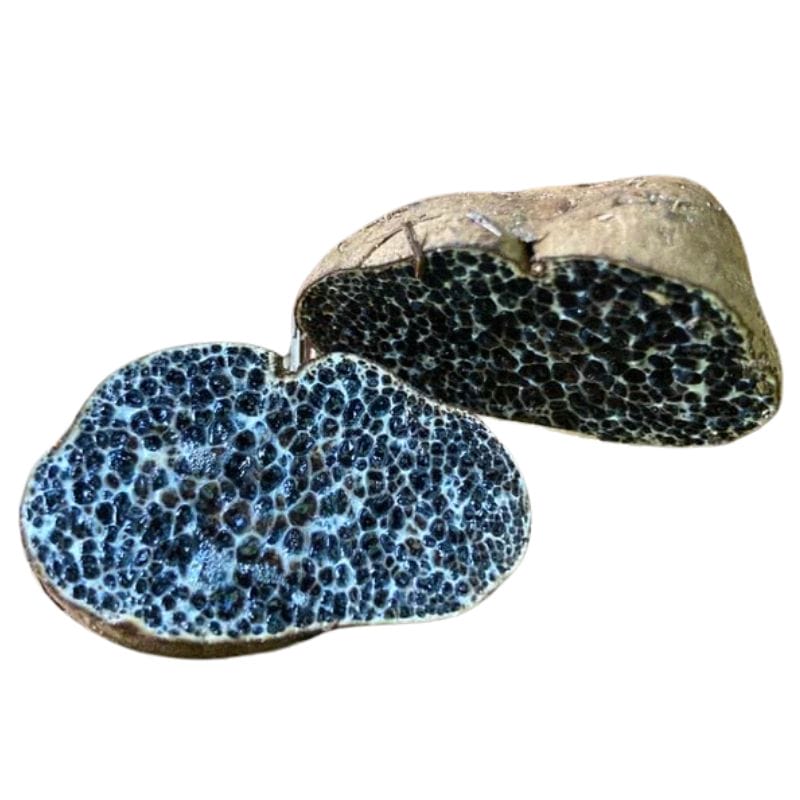
Melanogaster Ambiguus, because of their reddish-brown to dark brown exterior, might look like true truffles at first glance, but they’re quite different when you know what to look for.
The key difference is on the inside. When you cut open Melanogaster ambiguus, the interior is filled with flattened cells that have a shiny black gelatinous feel to them. Real truffles, on the other hand, have those beautiful marbled veins running through their flesh, almost like a web.
Another giveaway is the smell. While real truffles have a rich, earthy aroma that’s mouthwatering, Melanogaster ambiguus tends to have a much stronger, almost unpleasant odor—it’s not something you’d want to sprinkle on your pasta.
Earthballs (Scleroderma)
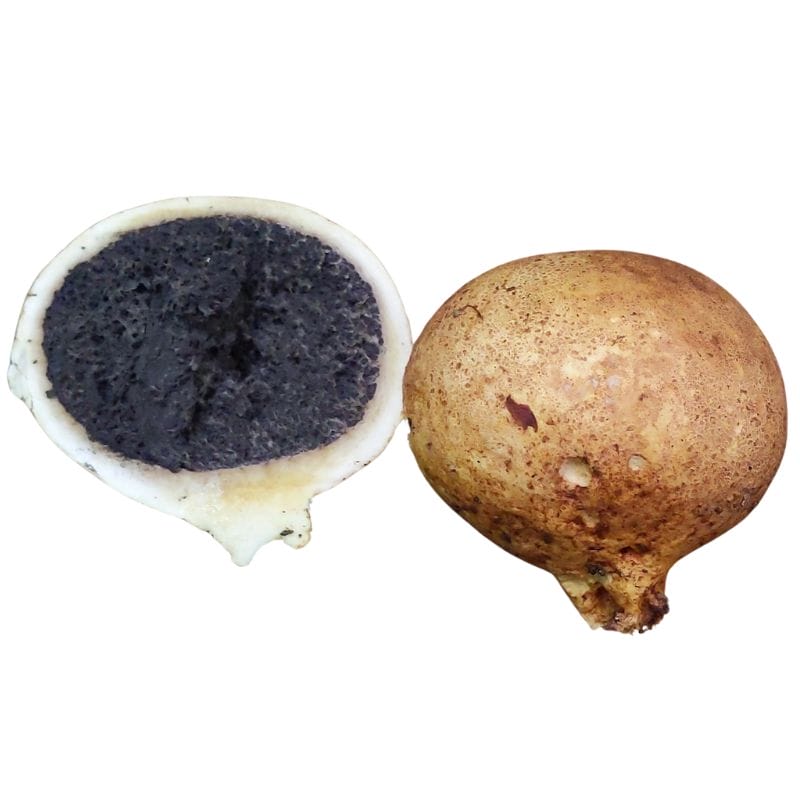
Scleroderma, commonly called earthballs, can easily fool someone who’s just starting out because they grow underground and have a round shape similar to truffles. But don’t be tricked—Scleroderma is not a true truffle, and it’s actually toxic, so it’s important to know how to tell the difference.
The first thing you’ll notice is the outer skin, which is thicker and tougher than that of most truffles. It can range in color from yellowish to dark brown, often with a rough or cracked texture.
If you cut it open, the difference becomes even clearer. While true truffles have a marbled interior with delicate white veins, Scleroderma starts out with a whitish inside that quickly darkens as it matures, turning black or purple with no marbling. It’s dense and solid, almost like charcoal in the later stages.
Another big giveaway is the smell. True truffles have a rich, earthy aroma that makes them so prized, while Scleroderma has little to no pleasant scent—some even describe it as musty or unpleasant.
Deer Truffles (Elaphomyces)
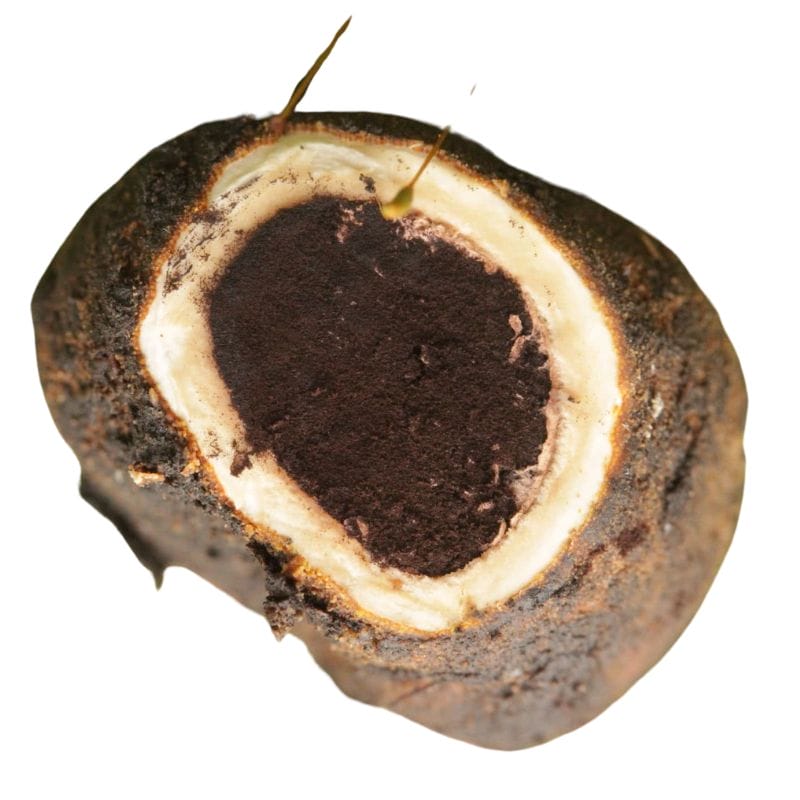
Elaphomyces, also known as deer truffles, look like true truffles at first glance, but they’re a whole different story. They’re called deer truffles because wildlife, especially deer and rodents, love to eat them. For us humans, though, they’re not edible—and definitely not what you want to mistake for a prized truffle.
Here’s how you can tell Elaphomyces apart from the real thing. First, they have a tough, warty outer surface that can range from pale tan to black, depending on the species and their age.
When you cut them open, the inside is solid and sometimes speckled or marbled, but not in the delicate, vein-like pattern you’d see in true truffles.
Their smell is also a big giveaway. Instead of the rich, earthy aroma of an edible truffle, Elaphomyces either has little scent or an odor that’s earthy but not particularly appealing.
Another thing to know is that Elaphomyces often grows deeper in the soil than true truffles, and they tend to have a harder, woodier texture.
Best Practices For Finding Truffles
Truffle hunting can be a rewarding adventure if you know the right tips and tricks. Here’s what you should keep in mind to improve your chances of finding these underground treasures:
Wait 10 to 14 Days After Heavy Rain
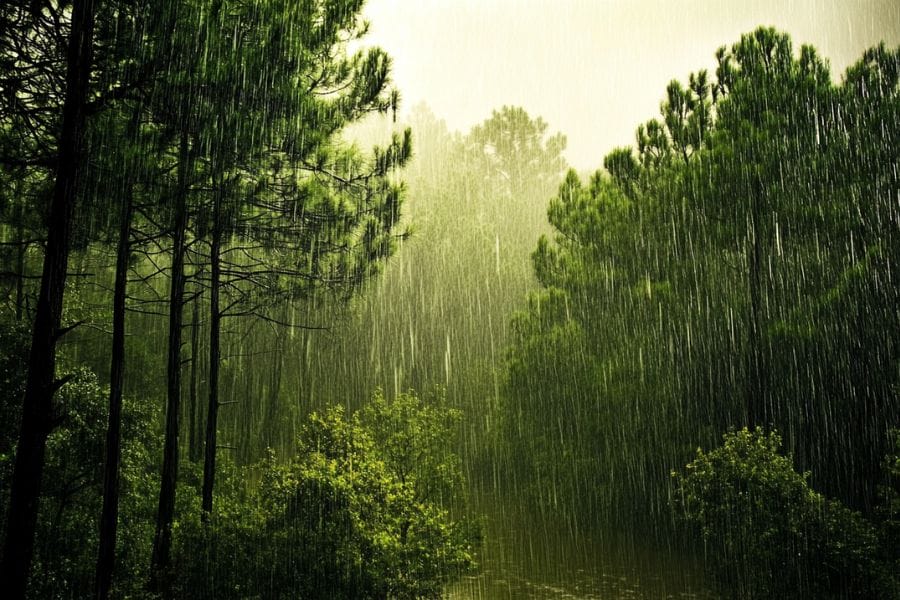
After a heavy rain, it’s best to wait about 10 to 14 days before heading out. This gives the truffles time to mature and release their signature aroma, making it easier for you (and your dog) to sniff them out. Rain helps truffles grow, but they don’t start giving off their scent right away.
As the soil warms up, the truffles get more aromatic, and the ground becomes looser, which makes digging easier without disturbing the environment too much. The timing is perfect to find truffles at their best—both in quality and in how easy they are to locate.
Find the Right Trees

Truffles don’t grow just anywhere—they have a special relationship with certain trees. You won’t find them under just any tree, so knowing which ones to look for can make all the difference. Some of the best trees to look out for are:
- Pines
- Douglas-firs
- Oaks
- Hazelnuts
- Cypresses
- Willows
For example, if you’re looking for Oregon white truffles, keep an eye out for Douglas-fir trees. California black truffles, on the other hand, are often found near oaks and hazelnuts. The soil around these trees also needs to be slightly alkaline, so it helps to know what kind of ground you’re walking on as well.
Watch for Wildlife Activity
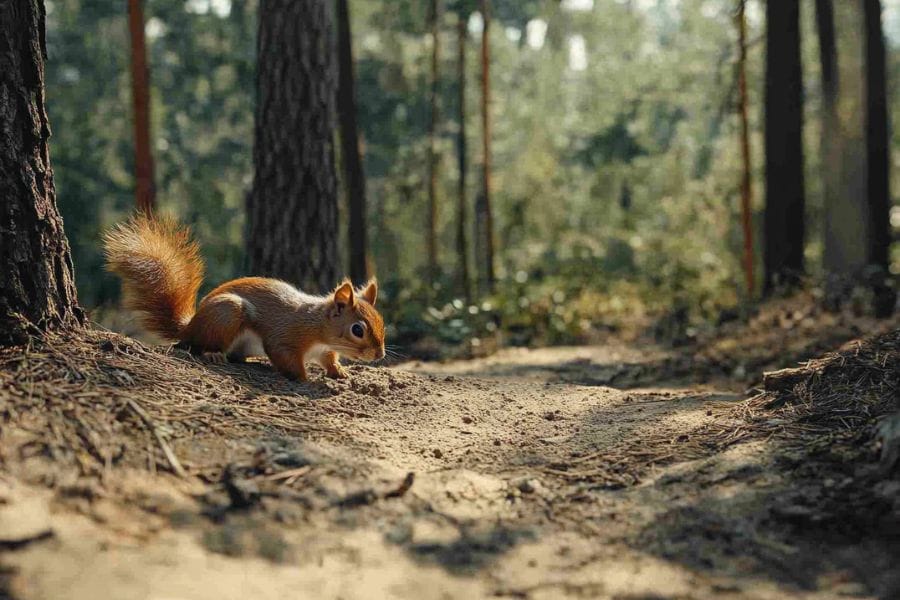
Animals like squirrels and chipmunks often help spread truffle spores, and sometimes their digging can lead you straight to truffles. While you won’t always find truffles in every pit animals dig (they also look for things like acorns or bulbs), fresh digs are a good clue. The more recent the pit, the better chance it has of leading to truffles.
Even though animals are a part of the truffle cycle, most hunters prefer using dogs to find the real treasure underground. Dogs have an incredible nose for truffles and can pinpoint their location much more reliably than any squirrel or chipmunk.
Get a Little Help from a Truffle-Hunting Dog
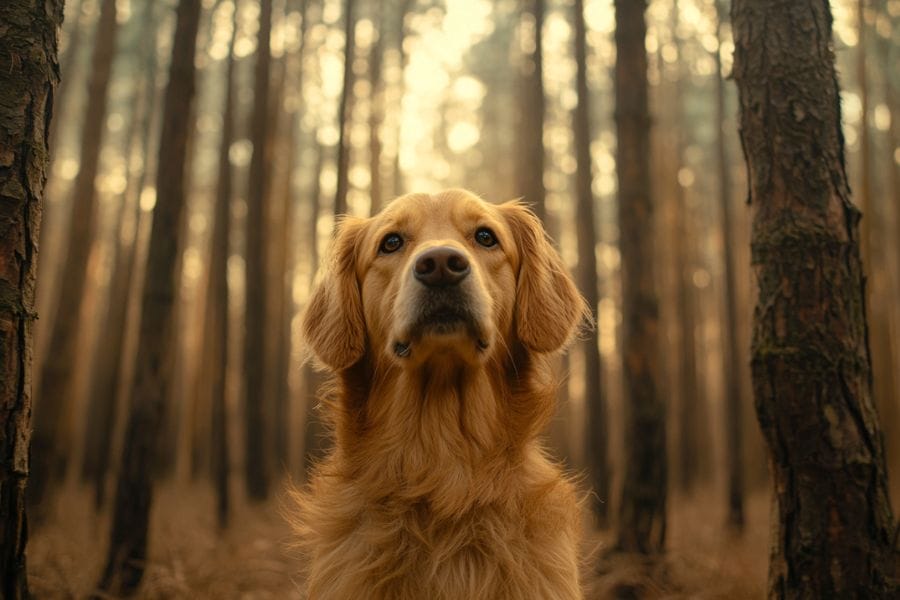
If you’re serious about truffle hunting, a trained dog can make your life a whole lot easier. Their sense of smell is extraordinary, and they’re trained to find mature truffles buried beneath the surface. Many truffle hunters swear by their dogs, and for good reason—they’re much more accurate than humans when it comes to sniffing out truffles.
If you don’t already have a trained dog, you can connect with local foraging groups or specialized trainers who offer truffle-hunting services. Some places even host events where you can see experienced handlers with their dogs in action. And if you’re feeling adventurous, you can train your own dog using truffle-scent kits and practice in a controlled space before hitting the woods.
Before you head out
Before embarking on any foraging activities, it is essential to understand and follow local laws and guidelines. Always confirm that you have permission to access any land and obtain permission from landowners if you are foraging on private property. Trespassing or foraging without permission is illegal and disrespectful.
For public lands, familiarize yourself with the foraging regulations, as some areas may restrict or prohibit the collection of mushrooms or other wild foods. These regulations and laws are frequently changing so always verify them before heading out to hunt. What we have listed below may be out of date and inaccurate as a result.
Where You Can Find Truffles Around The State
Now we’re going to go over five of the best locations for finding truffles. We’ll go a bit in-depth here and then provide a much longer list of other spots to try.
Tahquamenon Falls State Park

Tahquamenon Falls State Park spans over 50,000 acres in Michigan’s eastern Upper Peninsula, featuring the magnificent amber-colored Tahquamenon Falls. The unique tannic acid from cedar swamps gives the water its distinctive brown color.
Truffle hunters should explore the North Country Trail section where hemlock stands are oldest and undisturbed. The rich, moist soil here contains the perfect balance of minerals and organic matter. The Four Mile Trail between the Upper and Lower Falls has productive truffle grounds with varied terrain.
Look for slight mounds near mature hardwoods, especially areas with thick leaf litter. The park’s isolation means many patches remain unharvested. Visit after light rain when earthy truffle scents become more detectable.
Porcupine Mountains Wilderness SP
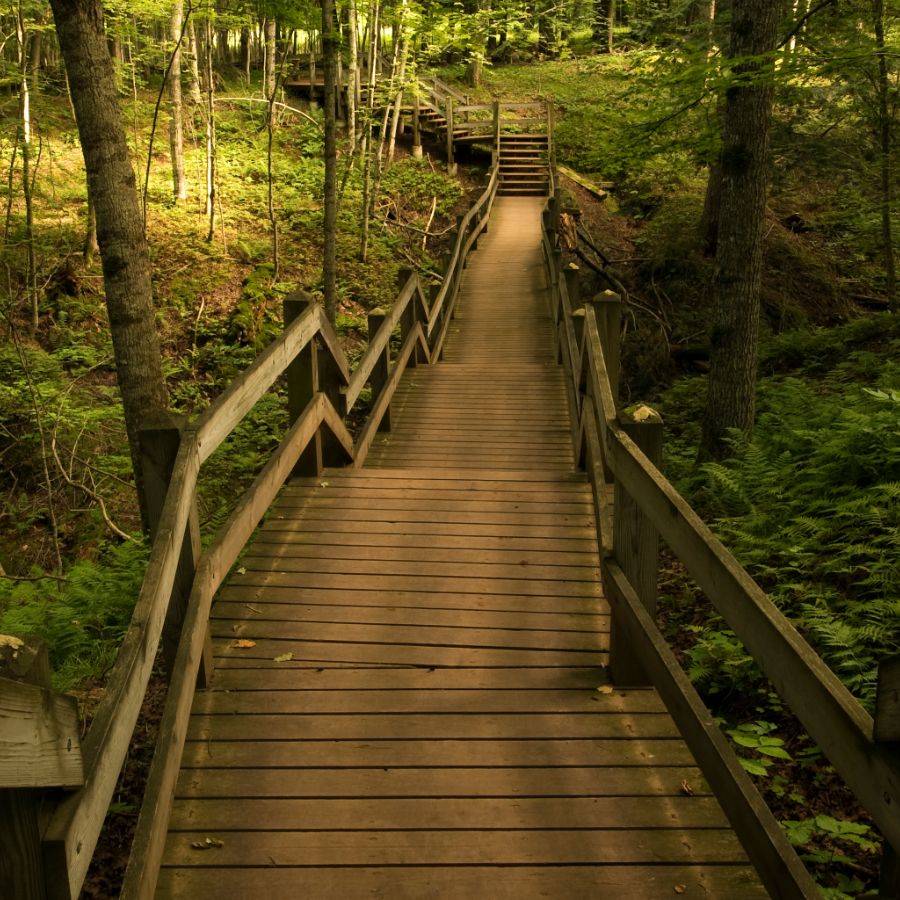
Porcupine Mountains Wilderness State Park protects 60,000 acres of rugged wilderness in Michigan’s western Upper Peninsula. The park’s most iconic feature is Lake of the Clouds, a stunning inland lake nestled among forested ridges. The Porkies contain one of the largest remaining old-growth hardwood forests in North America.
Experienced foragers recommend checking around Mirror Lake and the Presque Isle River, where the soil is particularly fertile. The escarpment trail with its limestone outcroppings provides excellent truffle hunting grounds with higher pH levels.
Some trees exceed 300 years old, allowing for extensive underground mycelial networks. The calcium-rich soil around Union Spring supports valuable truffle varieties not found in younger forests. The mixture of maple, basswood, and hemlock provides diverse host trees for truffles.
Hiawatha National Forest
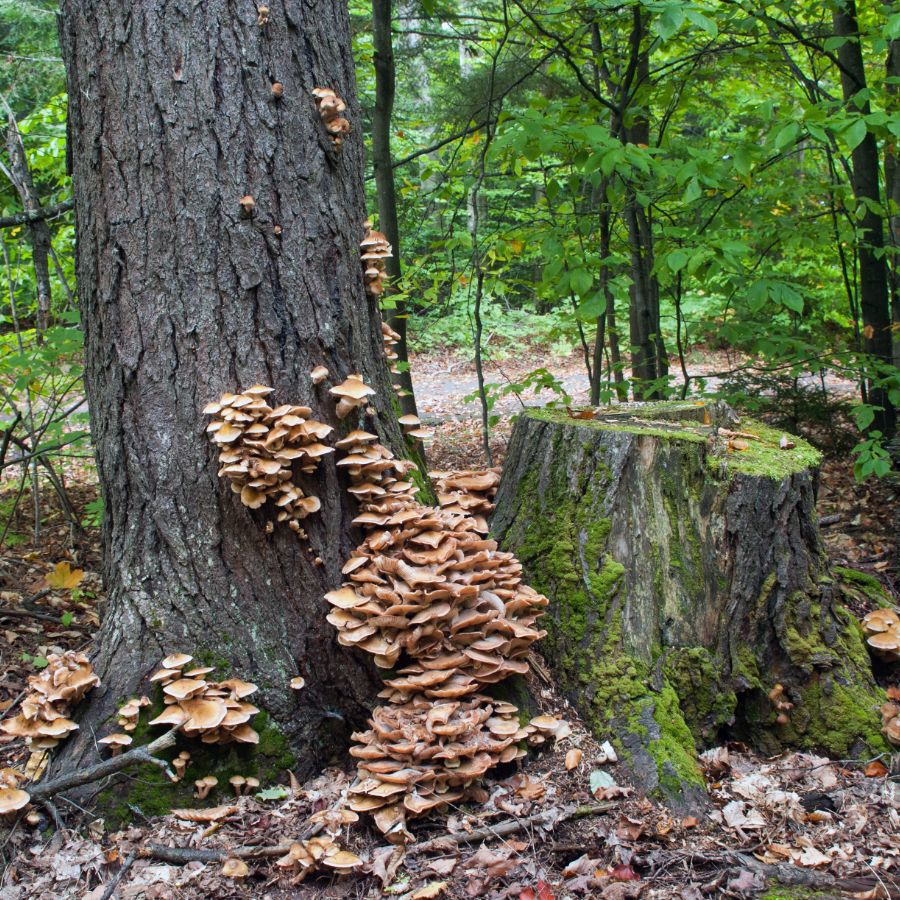
Hiawatha National Forest is characterized by its unique position between three Great Lakes, creating distinctive growing conditions across its 880,000 acres. The forest is home to six designated wilderness areas and over 100 miles of shoreline.
The northern location means truffles here often develop more concentrated flavors despite the shorter growing season. Look for ground showing slight bulges or cracks as signs of underground growth. The forest’s relative isolation means less competition from other foragers.
Truffles often form at borders between different forest types, such as where hardwoods meet pine plantations. The Bruno’s Run Trail System and Peninsula Point area have ideal combinations of tree species, ages, and soil composition.
Pigeon River Country State Forest
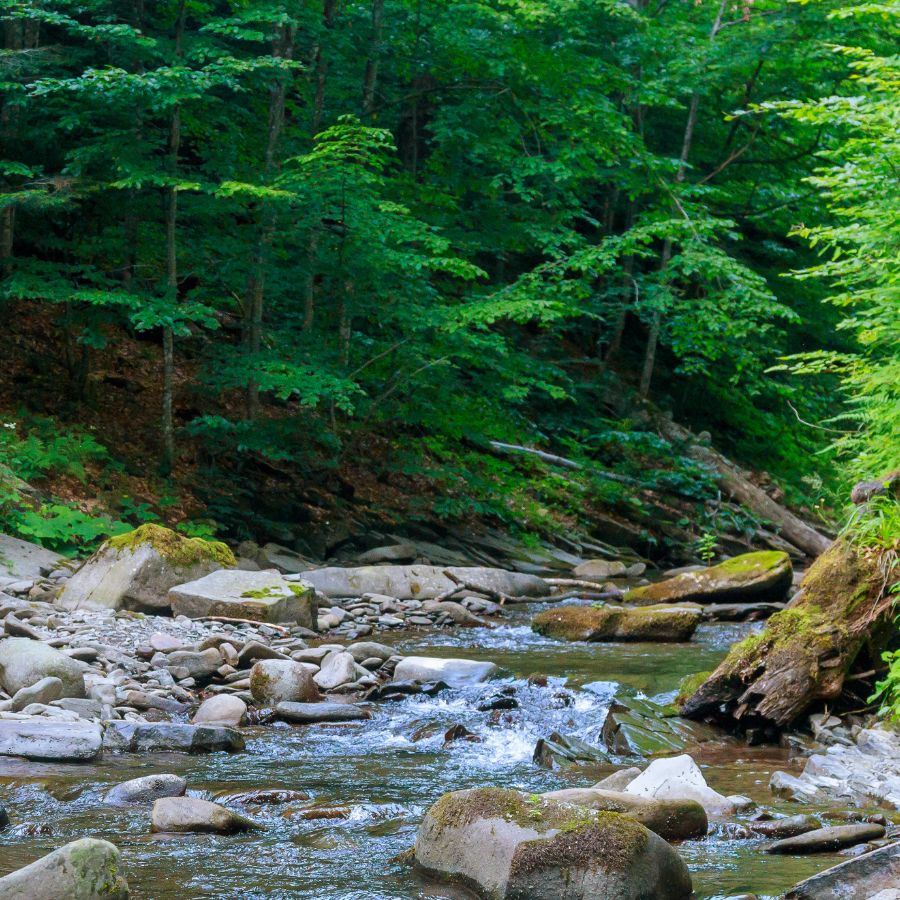
Pigeon River Country State Forest is known as Michigan’s “Big Wild” due to its remote character and abundant wildlife. This 100,000+ acre wilderness in the northern Lower Peninsula is home to the state’s only free-ranging elk herd.
Minimal human intervention has allowed natural fungal processes to flourish undisturbed here. The areas around Inspiration Point and Green Timbers have mature forests growing in mineral-rich soil ideal for truffles.
Search for slight depressions near tree bases, which may indicate where animals have previously dug. When finding one truffle, carefully search nearby as they typically grow in colonies. Carry a GPS device as it’s easy to lose orientation in this vast wilderness while focusing on the ground.
Huron National Forest
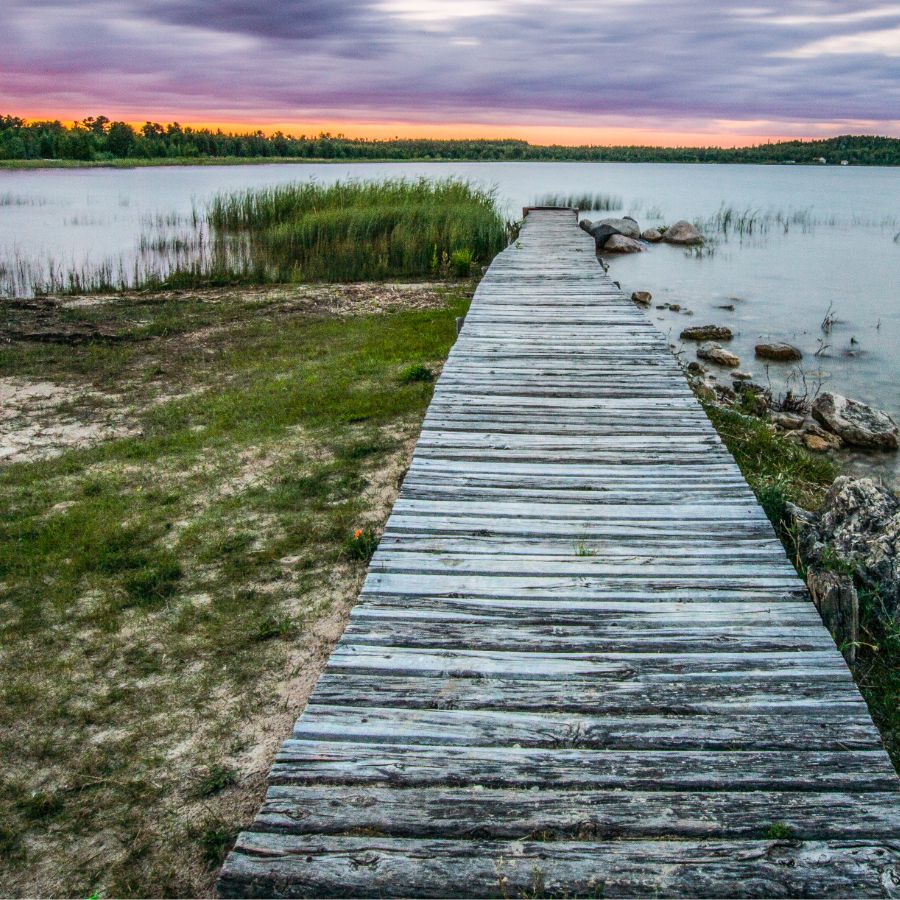
Huron National Forest offers a mix of outdoor recreation opportunities across its 438,000 acres in northeastern Lower Michigan. The Au Sable River, famous for blue-ribbon trout fishing, winds through its heart. This forest is characterized by gently rolling hills covered with diverse tree species.
The Eagle Run area and forests surrounding Lumberman’s Monument have historically yielded succesful truffle hunts. Use a truffle dog if possible, as dense understory makes visual identification challenging in many areas.
Look in places where the forest floor has a thin moss layer, indicating ideal moisture levels. The slightly acidic soil beneath pine stands supports unique truffle species not found elsewhere in Michigan. Due to the relativly dry climate, truffles often grow deeper here than in wetter regions of the state.
Other Great Locations For Truffles
| Upper Peninsula | What you can do |
|---|---|
| Baraga State Park | Collect small quantities of truffles and other fungi along the wooded Lake Superior shoreline. |
| Copper Country State Forest | Search mixed-hardwood stands; hand harvest for home use is allowed. |
| Craig Lake State Park | Search mixed-hardwood stands; hand-harvest for home use is allowed. |
| Escanaba River State Forest | Pick edible subterranean fungi throughout jack-pine openings. |
| Fayette Historic State Park | Take home a dinner’s share of mushrooms from forested quarry trails. |
| Lake Superior State Forest | Burn scars north of Newberry host truffles; personal use only. |
| Mackinaw State Forest (UP sector) | Sandy jack-pine plantations south of St. Ignace permit hand collection. |
| Porcupine Mountains Wilderness SP | Old-growth hemlocks conceal edible truffles—gather modest amounts. |
| Tahquamenon Falls State Park | Visitors may hand-pick wild mushrooms. |
| Van Riper State Park | Hardwood ridges near the Peshekee River allow small-scale foraging. |
| Northern Lower Peninsula | What you can do |
|---|---|
| Atlanta State Forest Area | Burned clearings offer spring truffles; hand harvest permitted. |
| Ausable State Forest | Gather mushrooms in sandy jack-pine country east of Grayling. |
| Burt Lake State Park | Take a basketful from mixed hardwood beds along the lake trail. |
| Hartwick Pines State Park | Collect edible fungi in second-growth areas outside the old-growth. |
| Hoeft State Park | Back-dune ridges allow personal truffle gathering. |
| Mackinaw State Forest (LP sector) | Lower-peninsula block permits non-commercial truffle harvests. |
| Otsego Lake State Park | Aspen/poplar groves open to dinner-size mushroom forays. |
| Pere Marquette State Forest | Post-burn corridors south of Kalkaska good for truffles—personal use. |
| Petoskey State Park | Dune-edge oaks host spring truffles; modest take allowed. |
| Pigeon River Country State Forest | “Big Wild” encourages hand-tool mushroom collecting for home meals. |
| Wilderness State Park | Forested interior west of Mackinaw City open to edible fungi picking. |
| Young State Park | Aspen ridges over Lake Charlevoix permit non-commercial gathering. |
| Central Lower Peninsula | What you can do |
|---|---|
| Barry State Game Area | Hand-pick edible mushrooms—including truffles—through oak barrens. |
| Gratiot-Saginaw State Game Area | Personal-use mushroom harvests allowed across both county tracts. |
| Ionia State Recreation Area | Mixed hardwood hills near Sessions Lake open to truffle foraging. |
| Maple River State Game Area | Lowland hardwoods provide legal, non-commercial mushroom picking. |
| Muskegon State Game Area | Pine-oak savannas yield spring fungi for household use. |
| Rose Lake State Wildlife Area | Trails northeast of Lansing allow hand-harvest edible mushrooms. |
| Saugatuck Dunes State Park | Back-dune zones welcome modest personal truffle collecting. |
| Sleepy Hollow State Park | Oak-hickory ridges around Lake Ovid open to small harvests. |
| Waterloo State Recreation Area | Michigan’s largest rec area invites hand-only truffle gathering. |
| Yankee Springs Recreation Area | Fire-managed oak-pine barrens yield truffles for personal meals. |
| Southern Lower Peninsula | What you can do |
|---|---|
| Brighton State Recreation Area | Pick edible subterranean fungi in oak-maple uplands. |
| Charles Mears State Park | Forested fore-dunes south of Pentwater allow a dinner’s share. |
| Fort Custer State Recreation Area | Oak ridges near Kalamazoo open to hand-harvest truffle hunting. |
| Grand Haven State Park | Interior cottonwood copses permit small personal collections. |
| Hayes State Park | Gather a basket from forest edges of Wampler’s Lake. |
| Highland Recreation Area | Glacial hills dotted with oaks allow legal truffle harvesting. |
| Holland State Park | Wooded dune shoulders near Lake Macatawa welcome limited picking. |
| Island Lake State Recreation Area | Collect wild fungi—including truffles—by hand for family meals. |
| Ludington State Park | Hardwood ridges between Hamlin Lake and the lighthouse open to foraging. |
| Pinckney State Recreation Area | Cedar swamps and barrens invite edible mushroom gathering. |
| Warren Dunes State Park | Forested back dunes yield spring fungi for personal use. |
| William G. Milliken State Park | Detroit riverfront woodland plantings allow limited collecting. |
When The Best Time Of The Year Is To Find Truffles
Truffle hunting in Michigan follows seasonal patterns. Most local varieties appear in spring and fall when soil conditions are just right. These underground treasures have specific timing that changes with Michigan’s weather cycles.
Spring truffles often emerge from late April through June. The warming soil creates good growing conditions. Many hunters find success as the forest floor warms and spring rains arrive.
Fall brings a second truffle season from September through November. The cooling temperatures with autumn rainfall create ideal conditions. These months offer another chance to find fungi before winter.
Moisture matters for truffle growth. Look after rainy periods when the ground has been wet. Some of the best hunting happens about a week following a good rain.
One Final Disclaimer
The information provided in this article is for general informational and educational purposes only. Foraging for wild plants and mushrooms involves inherent risks. Some wild plants and mushrooms are toxic and can be easily mistaken for edible varieties.
Before ingesting anything, it should be identified with 100% certainty as edible by someone qualified and experienced in mushroom and plant identification, such as a professional mycologist or an expert forager. Misidentification can lead to serious illness or death.
All mushrooms and plants have the potential to cause severe adverse reactions in certain individuals, even death. If you are consuming foraged items, it is crucial to cook them thoroughly and properly and only eat a small portion to test for personal tolerance. Some people may have allergies or sensitivities to specific mushrooms and plants, even if they are considered safe for others.
Foraged items should always be fully cooked with proper instructions to ensure they are safe to eat. Many wild mushrooms and plants contain toxins and compounds that can be harmful if ingested.

